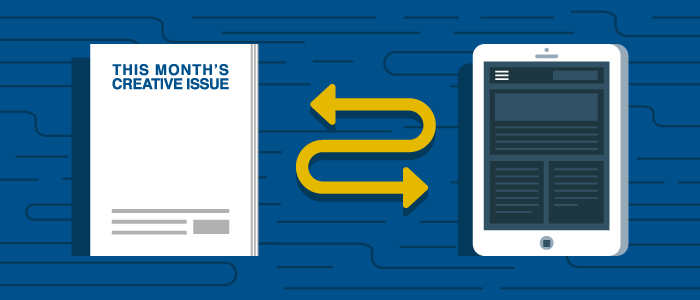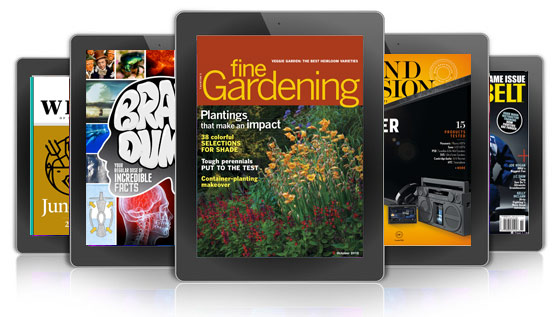
As the mobile publishing revolution has matured, we’ve been blogging about a lot of large, fancy digital magazines, particularly tablet editions. Publications like New York, Forbes, and The Atlantic have become leaders in what we consider the second phase of mobile publishing development – the technology is dependable, early jumpers are releasing their all-new versions upgraded from their 2010 efforts, and standards for what consumers are willing to pay for are becoming established.
But there are hundreds of smaller publishers out there bravely forging ahead without the expensive bells and whistles of the big boys. These companies are only on their first app iteration, not their second or third, and have substantially fewer resources to throw at a digital magazine.
These are the publishers for whom the digital replica was made. No one says you have to start out like New York, with a spectacularly innovative digital magazine platform. Nope, you can ease into the mobile publishing age with a simple digital replica magazine, and still satisfy your readers, your advertisers, and your bottom line.
[text_ad]
What’s a digital replica?

A replica edition is fairly simple, with print content digitized on pages exactly as the print edition does it. Usually this means simply uploading PDFs of your pages into software of some kind, or having someone else do it for you. The layout, advertising and content are exactly the same as the print version, no more or less, and each page, accessed by swiping horizontally, is identical to the print original.
(Note: If you currently create your magazine pages as PNGs, please resist the temptation to upload those. The iPad’s technology makes those pages look fuzzy and pixelated. And that’s definitely a no-no.)
Producing a digital replica is a fairly simple process now, with dozens of providers offering software and even hosting, marketing and analytics services.
And if you’re concerned that you’ll look like a publishing dinosaur by putting out a simple replica, the answer is it depends on your audience. These days, many perfectly respectable publishers are opting for the replica because of the lower price points for design (none) and production. Publishers in the business-to-business arena, or consumer publishers with older subscribers may even prefer this version of a digital magazine, bells and whistles free.
Among the simple replica brethren have been Fine Gardening and other Taunton Press publications, Sound + Vision and other Bonnier magazines; even a digital-only science magazine called Brain Dump.
So, you can create digital replica editions of your magazine, and you’d be in good company doing it, but the question still remains: Should you create a digital replica edition of your magazine?
[text_ad]
Digital replica: The cons
 Obviously the biggest downside to creating a digital replica of your magazine is that it’s an entirely new expense, requiring more manpower and technology that you never needed before the iPad came along. More on the actual costs later.
Obviously the biggest downside to creating a digital replica of your magazine is that it’s an entirely new expense, requiring more manpower and technology that you never needed before the iPad came along. More on the actual costs later.
In addition, many publishers find their sales staffers have trouble selling advertising now that it’s so much more complicated in the digital world. The metrics are complex and not standardized, and explaining the benefits to a new advertiser may take more knowledge than your print ad salespeople have.
From the consumer point of view, one of the biggest complaints we hear about replicas is the page, being simply minimized to fit into a tablet screen, delivers type that’s too small for many people to read. Enlarging the view then expands the page beyond the confines of the tablet screen, so the reader has to move the page around with a finger to read all of it.
We ran a study that asked digital magazine subscribers about their consumption habits. A full 50.75% of digital magazine subscribers told us scrollable text is an extremely important feature, one that a digital replica does not provide.
Another problem no one seems to be measuring is that a replica edition, if done sloppily, can generate animosity and drive consumers away from your brand – even longtime readers. In the app store, I see dozens of complaints about the technology of every magazine app I’ve ever reviewed here, and many I haven’t – and I mean 1 star ratings out of 5.
Digital replica: The pros
 So why should you trust your brand to a digital replica? Most importantly, because consumers expect and even demand a mobile version of your magazine. The longer publishers wait to jump on the bandwagon, the more they risk losing their audience to rivals who already have a mobile version.
So why should you trust your brand to a digital replica? Most importantly, because consumers expect and even demand a mobile version of your magazine. The longer publishers wait to jump on the bandwagon, the more they risk losing their audience to rivals who already have a mobile version.
On top of that, consumers are starting to actually prefer digital magazines to print, partly because of the convenience and, especially in the case of millennials, partly because of the green factor: A full 52% of respondents in a recent Mequoda survey said digital media’s lighter environmental impact was the main reason they subscribe to digital magazines.
And while I mentioned above our consumer research showing that the small type of a replica can be a pain for readers, there is an alternative to the basic replica that we call the “vertical swipe reflow,” which allows a larger font size as each article is then reflowed into a long single page that’s accessed by swiping vertically.
This is something most publishers could choose at a minimal expense – Mequoda, for instance, charges clients $50 per page to redesign a magazine to reflow – to overcome the replica “con” of small type.
Besides, consumers are increasingly willing to spend serious cash on mobile media, unlike expectations of website content back in the early Internet days when everyone demanded that all content be free.
We predict that publishers are circulating more than 80 million digital magazines, even though AAM is counting only a small percentage of that, due to the challenges of measuring magazine subscriptions in a universal pricing context.
You certainly want to be getting in on that action, even with a plain replica!
By the way, tablet magazine readers are also younger and more affluent, according to numerous studies – a two-fer that’s rare for any commodity – making them a tempting audience for both publishers and advertisers.
That’s one reason why you may also be able to charge higher prices for advertising. Another reason is that readers have been shown to be more engaged with, and spend more time on, digital content than on print. Although as we’ve noted, advertising rates appear to be lagging behind, others report higher prices being charged successfully.
Furthermore, by going electronic and taking delivery costs out of the equation, expanding your reach globally becomes far easier and less expensive. And as some publishers have proven, adding a digital magazine to your product line might allow you to actually raise subscription rates without substantial pushback from your readers.
Finally, data is starting to trickle in showing that digital subscribers, including those who get the digital edition as part of their print subscription, renew at higher rates and at higher price points. In a study we ran in 2014, 64% said they’d be more likely to purchase a bundle of print and digital than a single digital magazine subscription.
[text_ad]
So … is it worth your time and expense to publish a replica?
 While you’re weighing the above pros and cons, you’ll also need to consider cost. The best thing about the replica is that uploading PDFs is pretty much all there is to it: No need to redesign around fancy options like interactive ads, videos, or interactive content. If you want to move beyond the simple replica, most providers will happily do so for you, but let’s consider the basics of producing a plain replica.
While you’re weighing the above pros and cons, you’ll also need to consider cost. The best thing about the replica is that uploading PDFs is pretty much all there is to it: No need to redesign around fancy options like interactive ads, videos, or interactive content. If you want to move beyond the simple replica, most providers will happily do so for you, but let’s consider the basics of producing a plain replica.
When it comes to providers in this space, Adobe’s Digital Publishing Suite (DPS) is the granddaddy of them all. However, getting into DPS Enterprise requires an upfront cost of more than $50,000, and a significant cost per download. This makes DPS best suited for large, multi-title publishers.
The provider we recommend is Mag+. For Mag+, you’re going to pay a fraction of the cost per month to publish to all devices, and just a few pennies per download. (And unlike Adobe, Mag+ allows publishers to host their digital magazines themselves, eliminating the download cost.) This package is much friendlier to smaller publishers.
There are other digital magazine software options, too.
How much should you charge?
As I’ve mentioned before, pricing for digital magazines is as chaotic right now as your average Macy’s sale. No two pricing policies are alike! However, we’ve determined that the average single-copy price is $4.97, while the average 1-year subscription rate is $19.97. Some folks bundle their digital subscriptions with print for an extra $5-$10. Others maintain completely separate subscription options.
And, as we’ve also noted, if you’re feeling bold you can bundle your digital subscription with your print subscription, and take that opportunity to raise your print price.
Of course, the real question in pricing is how you’re going to break even and make money after investing in your digital edition. And as I said, the cost of going digital is complex enough to merit its own spreadsheet.
But here’s the bottom line based on Mequoda’s research so far:
To launch a simple replica, you may pay about $8,400 per year for Mag+, plus another $2,000-$3,000 in labor. If you have a $30 subscription, with the average 70% remit, you’ll need to sell 500 subscriptions to break even. And even the smallest of publishers we’ve heard from are selling that number, even as many as 10,000 or more in their first year. If that’s not enough to get you on the digital bandwagon, I don’t know what is.
As I mentioned, there are dozens of replica editions already out there, and there are enough advantages to mobile publishing that Mequoda believes no one should hesitate. And if you have any experiences with replicas to share, or have questions about going digital, please let us know in the comments below. We’re all still learning the ropes as mobile publishing evolves daily!



Greg is strictly looking at this from his standpoint…and just might think everyone is a study of himself. Sorry Greg, go out and bring the subject up with people you don’t know…ask them if you might ask them a couple questions. If they go along…ask your questions. Now shut up and listen. Don’t try to convince them to your way of thinking. You will finally learn how totally wrong you are by saying “the digital magazine is a total waste of money from the get go.
Now a real lesson…it costs a minimum of $2+ for any publisher to manufacture/produce one issue of one magazine…this includes postage. Since 2008 advertising is off by at least 50-60%…for some magazines 80+%, soon you will see many magazines totally stop printing…and you will only get it digitally. What then, Greg?
And, Greg, in case you didn’t see it, our study found that digital magazines have a penetration of 1/3 of American adults, not 3%. Modern print magazines have been around for well over 100 years and have a penetration of 2/3 of Americans. (See The Mequoda Digital Magazine Market Study & Handbook — http://www.mequoda.com/free-reports/digital-magazine-study/).
Digital magazines have achieved half that penetration in just 5 years. I could describe that development in many ways but “dying” and “fading” are not terms that would come to mind.
Hi Greg — We’re going to have to agree to disagree on the digital magazine being a mistake from the start. I think the tablet is the platform magazines have always wanted but just needed to give the tech world time to catch up.
Where I do agree with you is that publishers have wasted an enormous amount of money designing tablet editions. In fairness, there’s always some “waste” when a new format comes along while usage patterns and norms get established.
Movies are often viewed on phones, phablets, tablets, laptops and TVs but many are still shot for the big screen which is their intended platform. Magazines being optimized around tablets is similar — it’s the optimal platform, even if much of the consumption happens on others.
I agree mobile is an important, and increasingly important, platform, and one that publishers should allocate resources to. I don’t think it’s an either/or situation though.
I remain of the opinion that the “digital magazine” has been a mistake from the start. Publishers have wasted enormous amounts of money designing fancy tablet editions of their publications for the 3% of their readers who use a platform that is, if not dying, certainly fading.
The tablet is being eclipsed by large-screen smart phones.
Publishers should definitely have an appropriate digital strategy — especially for mobile — but I think it’s counter-productive to think of it as a “digital magazine.” It’s a confusion of terms. Forget “magazine” and think “how do I repurpose this content for this other experience?”
The place to put your development resources is in designing content for smart phones.
No worries Tom. I think you will find this article on magazine pricing helpful — http://www.mequoda.com/articles/digital-magazine-publishing/which-digital-magazine-pricing-model-generates-the-highest-revenues/.
Ed,
Sorry about addressing my previous comment/question to Don–thank you for YOUR article!
Tom
Don,
Thanks for the great article. We bundle our digital replica magazine, with the print and access to our HTML library, at a slightly higher rate for the combo. But we also offer a lower-priced DR sub that includes the HTML library.
What’s the typical price difference between online and print for trade professional mags? Our DR/HTML price is $55, 35% less than the print+DR/HTML combo, but I’m finding that too many lapsed subs report that the DR/HTML price is still too high, given all the free content out there.
Or publishers can just use publishing platforms already in place like Issuu and MagCloud.